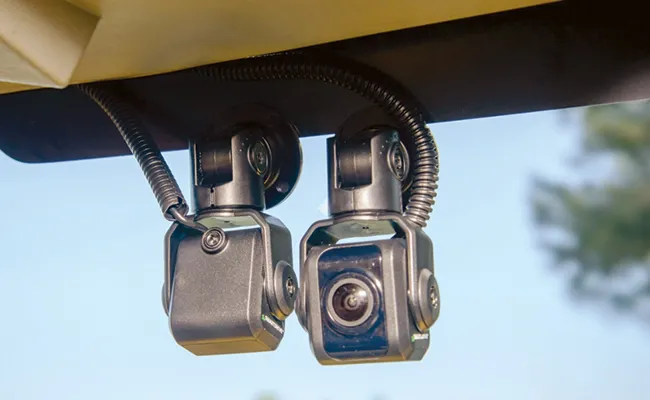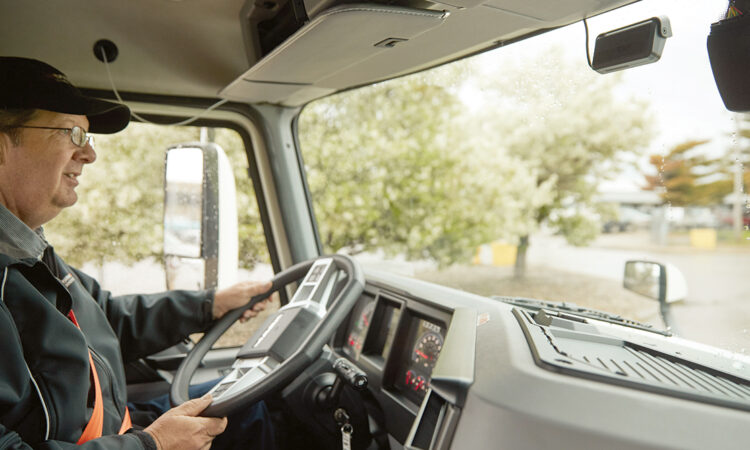Forward- and Inward-Facing Cameras Provide New Insights, With Help From AI
The use of cameras on heavy-duty trucks has gone mainstream as more and more fleets have adopted forward- and inward-facing cameras to coach drivers and reduce liability.
Now the latest smart camera technology is taking things a step further, helping carriers capture more angles, gain new insights and derive more operational value from video.
“If I go industry by industry, they’re all finding creative ways to use video to enhance their safety and nonsafety use cases. It is actually adding value beyond changing behavior,” said Rajesh Rudraradhya, chief technology officer at video telematics provider Lytx. “We used to educate fleets on why they need video and how it can exonerate drivers and change driver behavior. Now fleets come to us, tell us their needs, and ask how we can solve their problems.”
Jean-Sébastien Bouchard, co-founder and executive vice president of sales at telematics provider Isaac Instruments, said the top reason fleets deploy cameras remains the same — to understand what happened after a crash and aid in litigation — but they are also using the technology to drive operational improvements.
“Now that they have a camera capturing the events, they’re trying to proactively help their safety culture with the videos their systems are able to collect,” he said.
Mark Schedler, senior editor for transport at regulatory compliance firm J. J. Keller & Associates, said the trucking industry has rapidly implemented road-facing and driver-facing cameras during the past five years as price reductions and quality improvements started accelerating.
The addition of artificial intelligence and computer vision has added context to what is happening inside the cab and on the road, identifying risk and alerting drivers in real time.
“In the long run, it improves driver behavior,” said Abhishek Gupta, vice president of product at technology vendor Motive, formerly known as KeepTruckin.
Rapidly identifying potential safety risks has enabled fleets to become proactive rather than reactive. “The biggest change in my mind has been the ability to assist drivers in real time,” said Ingo Wiegand, vice president of product at Samsara, another fleet telematics provider. “We can detect the speed limit to determine if you’re following too closely, or we can see a phone is in the hand of a driver for a certain period of time, indicating the driver is distracted.”
Bouchard said Isaac’s cameras detect posted speed limits, including those in a construction zone that may not be in a database, and can identify stop signs.
“Drivers can be monitored on rolling stops,” he said.
Matthew Carter, manager of sales engineering at transportation technology firm Trimble, said AI can detect everything from lane departures to drowsy driving.
“The biggest trend happening in video intelligence systems today is the aggressive usage of AI in new and creative ways,” he said, adding that adoption of inward-facing cameras has increased with the addition of AI features.
To help identify situational risks, Lytx has developed features to assist with weather and road conditions.
“We are showing alerts based on the safe speed for the conditions they’re in,” Rudraradhya said.
Image

Many trucking companies incorporate video into driver coaching sessions. (Lytx)
Lytx also has launched an unsafe parking alert if drivers are parked on an off-ramp or other risky scenario and can assess route risks using publicly known crash information and anonymizing client data.
“We’ve enabled it so, depending on the risk on a particular route, they can apply their best driver for that route,” Rudraradhya said.
AI also can enable a more nuanced understanding of safety by considering the situational context.
“If you have a driver driving across the country and a driver driving locally, you can’t compare the two. The road conditions and context are different,” Rudraradyha said.
Rather than treating all instances of speeding or following too closely the same, some video safety systems are assessing the safety risk involved.
“It was a hard brake, but the fleet doesn’t have to look at the hard brake unless it is annotated with risk. We find the risk, annotate it, and it goes into a workflow for the fleet,” said Jeff Griswold, vice president of product management at Solera, which offers the SmartDrive video safety program.
AI can support proactive decision making, explained Mayank Sharma, head of global product management at Teletrac Navman, another fleet technology vendor.
“You can set up the alerts to be real time, near real time or post hoc,” he said. “The advantage with these systems now compared with older systems is they are highly configurable.”
Image

Onboard cameras have become increasingly commonplace in the trucking industry. (Solera)
Field services contractor and private fleet operator Cascade Environmental, based in Bothell, Wash., uses cameras from Motive as an intervention and coaching tool.
Alex Amort, the company’s vice president of compliance, said AI is good at determining what the driver is doing, identifying risky behaviors and providing alerts on issues that need attention.
“We’re not sitting there watching footage of nothing. I have more important things to do,” he said.
A Sharper Focus on Safety
Video telematics providers are enabling fleet customers to track safety trends and more effectively manage risk.
“We can identify the most common or prevalent behaviors to help manage what is relevant. If a driver has done something a couple of times, it is a higher priority,” Samsara’s Wiegand said. “A lot of fleets have a small safety team and a large number of drivers, so we’re making it easy for them to prioritize.”
Trimble combines video metrics with engine data, safety scores, driver behavior metrics, real-time speeding evaluations and hours-of-service records to provide fleets with a long-term, coachable view of the overall safety performance of each driver.
“This holistic view of drivers allows the fleet to recognize the long-term safety habits of their professional drivers,” Carter said.
Isaac’s Bouchard said collecting more data means there is more information for fleets to analyze, so technology providers must concentrate on capturing insights that are truly important to them.
Bouchard added that Isaac looks for ways to reduce the number of images and videos that fleet customers need to watch.
“We work with fleets on making drivers more autonomous with self-coaching. That minimizes the amount of touch points,” Bouchard said.
Tucker Freight Lines, a trucking company based in Dubuque, Iowa, uses Isaac’s real-time, in-cab coaching.
“We have some drivers who receive that alert and call their safety coach before the safety coach even looks at it,” said Lynn Berning, the fleet’s risk and compliance manager.
In-cab alerts can deliver quick wins, such as getting drivers to put down their cellphones. “There is an 80% reduction in cellphone use,” Lytx’s Rudraradhya said. “We also have a combination alert that says you’re on your cellphone and within 3 seconds of a collision because we’re checking how closely you’re following the car in front of you.”
Samsara also uses voice directives once a camera detects certain conditions.
“It will chime an in-cab audio alert and say please put down the phone or increase the following distance,” Wiegand said. “There are so many things that commercial drivers have that ding at them, so having an actual voice is very directive.”
Driving Efficiency With Video Insights
Real-time coaching can drive a variety of operational improvements, including fuel efficiency.
“We tell the driver how much pedal to use and to coast when he approaches a stop,” Bouchard said. “In doing this, Isaac customers will say they save 5% across the board.”
Berning of Tucker Freight Lines said a half or three-quarter-mile per-gallon improvement can be very significant to the company’s bottom line.
“If they’re running 3,000 miles a week, that is a big deal,” she said.
As an example, Berning said the fleet was able to identify and coach a driver who had been recording a lot of hard turns, resulting in less stress on his vehicle and better fuel mileage.
Similarly, drivers at Cascade Environmental learned they had to stop and accelerate more slowly to avoid triggering events, which also protects equipment and improves uptime.
“When you’re driving overweight with a permit drill rig, any tiny bit you can save on the braking and wear and tear is fantastic,” Amort said. “Some drill rigs are worth over $1 million. They’re expensive pieces of equipment. The last thing you want is them to be down due to poor driving behavior.”
An Expanded View of the Road
Fleets also are seeking a broader perspective of the truck’s surroundings since much of what happens on the road does not occur directly in front of the truck.
“There are vehicles in neighboring lanes, vehicles approaching from the side, vehicles approaching from the rear, and other factors that intrude on the commercial vehicle’s safety zones,” Trimble’s Carter said.
About 40% of Isaac’s customers are interested in side cameras, Bouchard said.
“A lot of accidents happen with objects or vehicles coming from the side. Having the side cameras help fleets prove without a doubt they don’t have responsibility,” he said.
A driver at Rio Valley Biofuel Transport was exonerated when the driver-facing camera captured video out of the passenger and rear windows of another vehicle striking the trailer.
“The driver-facing camera is what actually caught the accident. It completely stopped any litigation that could have come from that,” said Maridee Jenkins, compliance and safety lead for the fleet.
Gupta said Motive’s AI Omnicam monitors a vehicle’s side, rear, passenger and cargo areas.
“It gives you visibility across all sides and enhances your safety and day-to-day operations,” Gupta said.
Video also can extend to drivers’ work outside of the cab, such as delivering fuel or tarping a load.
“Having camera views of the driver activities around the vehicle helps fleets understand how injuries happened and whether employees adhered to standard operating procedures and best practices,” Solera’s Griswold said.
AI and Reducing Risk
Teletrac Navman’s Sharma said adding AI to side cameras can enable new functionalities, such as identifying pedestrians.
“In some countries, you have to have that technology in place by regulation. We offer that in five regions and are bringing it into the U.S. as it makes sense,” he said.
Additional views also can help deter theft or catch criminals.
“It can be used by law enforcement to see the faces of the perpetrators or the year, make and model of the car that was involved,” Solera’s Griswold said.
Camera technology has improved in both capability and price, enabling high-definition videos that provide more detail.
“If you have an impact, you can read license plates on the vehicles around you that you couldn’t gather before,” Isaac’s Bouchard said.
Schedler said a 2019 survey of 211 fleets conducted by J. J. Keller found that among respondents using dashcams and video-enabled driver coaching, nearly 30% received a discount on insurance premiums.
Some insurance carriers are even requiring camera systems to obtain coverage because they “greatly reduce overall claims and losses,” Trimble’s Carter said.
However, Bouchard said just having a camera onboard isn’t enough.
“It isn’t because you have a camera you’re better,” he said. “It is what you do with that camera that makes you better.”


